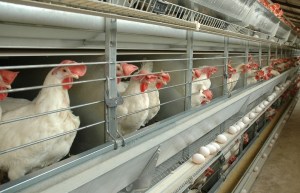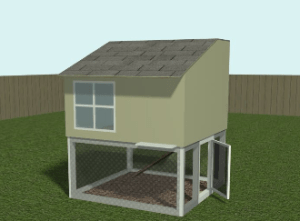Category : AGRICULTURE-LIVESTOCK
Name : Poultry-Chicken Egg Production
Description : You can keep chicken for both egg and meat production. You may consume for your own need or you may sell. Especially while keeping and feeding your chicken naturally and organic, you may open a new market segment and demand. Also, you may sell them with higher price.
Productivity : Each hen can give 6 eggs per week. 200-280 eggs per year.
Land : Depends on the size of your farm you must have large enough land. While selecting area, you must consider closer to market, low cost of land, low cost for workers, water supply, security especially for wild animals, protected from wind. Also it must not so close to water reserves like river or lake to protect from possible pollutions from your farm.
 Keeping-Cage : While keeping your hens in cage, you may use smaller area, you can keep egg and area cleaner, you can better protect and easily collect eggs. Also, you can keep them healthier and could feed with less food.
Keeping-Cage : While keeping your hens in cage, you may use smaller area, you can keep egg and area cleaner, you can better protect and easily collect eggs. Also, you can keep them healthier and could feed with less food.
One of the option called battery cage system. It is expensive, but save spaces. Here hens are kept throughout their productive life time in cages. In a battery cage system, hens do not have contact with droppings which reduces infections. Feeding, providing water, egg collection, removal of litter and cleaning are easier for the poultry attendants to perform. Battery cages can hold 1-5 hens per cage (50x40x45 cm per chicken)
You buy ready one or you may make your own cage. Cage must be higher than surface to let mature to fall down, and must be cleaned easily.
Cage must be protected from sun and rain.
Keeping-Indoors on the Floor : Hens kept indoors and on the floor with adequate floor space. Feeders,  drinkers, perches and nest boxes must be provided on the ground. Floor litter is necessary and later can be used as fertilizer or compost on gardens. Some of the eggs will be laid on the floor and some of these can get dirty and must be cleaned. Green grass, cassava, vegetables can be given.
drinkers, perches and nest boxes must be provided on the ground. Floor litter is necessary and later can be used as fertilizer or compost on gardens. Some of the eggs will be laid on the floor and some of these can get dirty and must be cleaned. Green grass, cassava, vegetables can be given.
Keeping-Outdoors-Free Range : It is like keeping-indoors on the floor but chickens are allowed to outside. They are allowed to go indoors at any time. Floor space 7 – 8 hens per square metre. Night they are locked in. House similar to that for barn hens with nest boxes, drinkers and feeders. Drinkers are also provided in the outside enclosed area. Space per bird in the house is a little less than for barn hens. In this system, hens can search for some of their feed and pick up some essential nutrients. Hens need green feed and there should be two separate  outdoor pens which can be rotated. One will be rested to allow the grass to grow back. Sunlight provides birds with vitamin D. Also, you may sell the eggs with a higher price. As disadvantages, hens will eat a little more feed and lay fewer eggs than a battery (caged) hen. They are more likely to pick up a disease (parasites) outside.
outdoor pens which can be rotated. One will be rested to allow the grass to grow back. Sunlight provides birds with vitamin D. Also, you may sell the eggs with a higher price. As disadvantages, hens will eat a little more feed and lay fewer eggs than a battery (caged) hen. They are more likely to pick up a disease (parasites) outside.
Hens : You may buy chicks and rear them. But it is better to buy young hens (18-20 weeks old, chickens often start dropping their first egg from 22 weeks to 24 weeks of age) and start production. Hens must be healthy and must have all necessary vaccines.
At first eggs will be smaller and by time will be bigger.
 You must keep hens for 1 year or 2 maximum, after that their egg productivity will start to decrease. And you must start again with young hens.
You must keep hens for 1 year or 2 maximum, after that their egg productivity will start to decrease. And you must start again with young hens.
While you are changing your hens, you must keep the old ones until new ones start to have eggs. Otherwise, you can disappoint your customers.
Light : It is better to provide 16 hours of light to them. You may adjust with automatic timer and electrical light. Hens only with daylight can produce 200 eggs per year, but with artificial light they can reach up to 280 eggs per year. If you are planning to use only natural light, keep them on a sunny place but keep protected from direct sunlight.
Food : They need calcium to have a hard, strong egg shells. It is best to feed by good, well known commercial foods. These foods are specially formulated to provide all the nutritions they need in the correct composition.
Food and clean water always must be available. Each hen will consume around 150 grams of food. Water must be automatically supplied through special feeders.
You may estimate approximately 1.5-2.5 dollars feeding cost per hens per month.
Cleaning : Fresh manure can be covered with a layer of sawdust, dried leaves, grass, etc every day. It will become good compost if turned regularly. This method also helps to remove bad smells. It can be sold as organic fertilizer or compost for vegetable gardens. You can also use it for your own garden.
Size of Investment: It all depends on your target market. For each hens you can have 280 eggs yearly. For small projects you can invest less and for further growing check for available bank loans.
For small farms (less than 10,000 hens) must consider to sell directly and must concentrate mainly for selling.
One of the main investment will be housing for hens. It all depends on your budget starting from almost zero up to 10 dollars/hen for fully automated-high-tech turn key cages.
Cost of chicks (18-20 weeks old) may be estimated as 2.50-3.50 dollars each.
Health : It is very important to buy healthy, vaccinated chicks from a reliable producer. Always supply clean and fresh food and water.
Keep wild birds far from them and their food.
Protect them from direct sunlight, rain and cold. If you learn an epidemic poultry disease, directly call your vet.
Additional Sources :





Thanks for the good writeup. It in truth was once a enjoyment account it.
Look advanced to far added agreeable from you! However, how could
we keep up a correspondence?